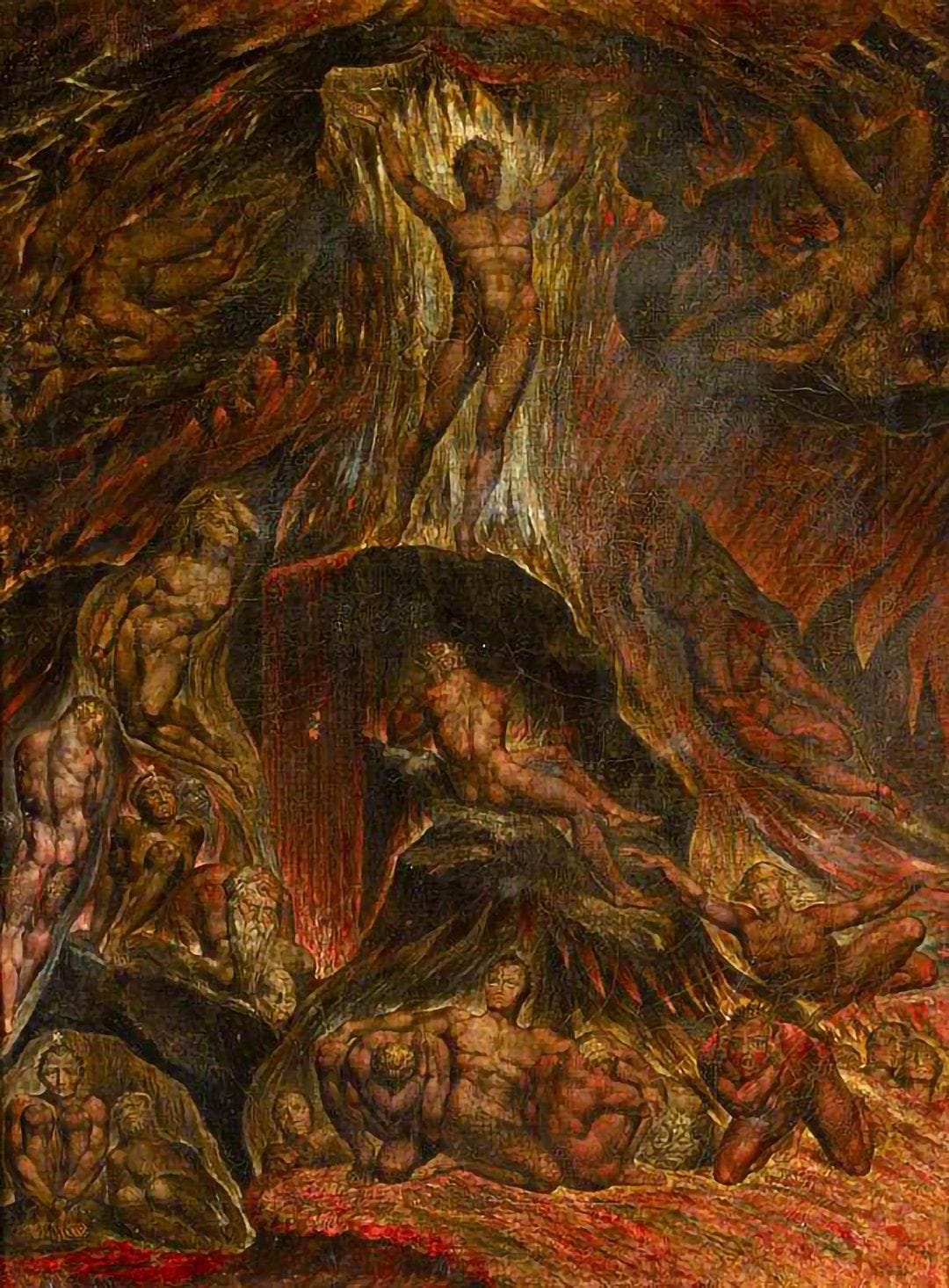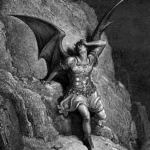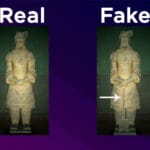Sir Thomas Lawrence’s colossal Satan Summoning His Legions (1796-1797) isn’t just a painting; it’s a tempest of Romantic-era artistic ambition, theological provocation, and personal drama. This monumental oil on canvas, measuring an imposing 9 ft x 14 ft, resides within the hallowed halls of the Royal Academy of Arts in London, a testament to its enduring power. It invites viewers into a scene of breathtaking darkness, a swirling vortex of demonic figures coalescing around a central, dominant figure: Satan himself.
The Fallen Angel: A Portrait of Defiance
Inspired by Milton’s Paradise Lost, Lawrence’s Satan transcends mere illustration, offering a complex portrayal of fallen grandeur and the seductive nature of evil. The artist doesn’t shy away from the physicality of the Devil; he is depicted predominantly nude, wielding a sword and helmet, his body twisted in a dynamic pose that suggests both vulnerability and immense power. This depiction likely drew heavily from Book 1, lines 338-355 of Milton’s epic poem, where Satan rallies his fallen angels in the fiery abyss of Hell. However, Lawrence’s interpretation veers from simple depiction into a nuanced exploration of rebellion and the alluring darkness within human nature.
The legions themselves are a nightmarish ballet of contorted forms, their faces etched with suffering and malevolence. Some seem to claw towards Satan, while others writhe as if trapped, their expressions a chilling blend of fear and hatred. This probably suggests not only the horrors of Hell but also the diverse temptations and sins that bind these tormented souls. This portrayal may have been informed by earlier depictions of demonic figures in art and literature, although further research is needed to pinpoint specific influences.
A Window into Romantic-Era Anxieties
More than brushstrokes and canvas, Satan Summoning His Legions encapsulates the artistic anxieties and societal shifts of late 18th-century England. The Romantic movement, with its emphasis on powerful emotions, the sublime, and the supernatural, found a potent expression in Lawrence’s work. The era’s social upheavals and revolutionary fervor may have resonated with the painting’s theme of rebellion against established authority, adding another layer of complexity to its reception. The painting’s scale and dramatic presentation further underscore the Romantic fascination with grand themes and intense emotional experiences.
Lawrence, primarily known for his celebrated portraits, took a bold step outside his established genre with this ambitious history painting. It is a testament to his artistic versatility and his desire to grapple with profound theological and philosophical questions. Further research into the model Lawrence used for Satan could provide valuable insight into the artist’s process and intentions. Some scholars suggest that Lawrence’s tumultuous love affair with Sarah Siddons’ daughter may have influenced the painting’s emotional intensity, adding a personal dimension to this grand, epic narrative.
A Legacy of Provocation and Debate
The painting’s reception, from initial criticism to modern interpretations, reveals the enduring power of art to spark debate and challenge our understanding of good and evil. Early reactions were predictably mixed. Some lauded the painting’s grandeur and ambition, while others criticized perceived anatomical inaccuracies and its theatrical quality. This contrast in opinions perhaps amplified its impact, ensuring that Satan Summoning His Legions remained a subject of discussion and analysis.
Today, the painting continues to fascinate and provoke. It invites questions about the nature of evil, the allure of power, and the eternal struggle between light and darkness. Some may see Satan as a tragic hero, a fallen angel who dared to defy divine authority. Others may interpret him as the embodiment of pure wickedness. This ambiguity, the lack of a single definitive interpretation, is precisely what makes the painting so compelling. It serves as a mirror reflecting our own internal struggles, our capacity for both good and evil.
Modern interpretations often explore the painting’s psychological dimensions, linking it to Lawrence’s own life and experiences. Comparing Lawrence’s portrayal of Satan with other artistic depictions, such as those by John Martin, William Blake, and Gustave Doré, can reveal the evolving cultural understanding of this iconic figure.
If you are interested in learning how to make your very own custom designs for your island, be sure to check out our helpful guide on scenic painting acnh. And if you are a big fan of the Valiant Statue, you are going to want to see our complete guide on valiant statue acnh.
Unveiling the Depths: Ongoing Research
While much has been written about Satan Summoning His Legions, many questions remain. Ongoing research continues to explore the painting’s historical context, Lawrence’s artistic influences, and the potential symbolic meanings embedded within the swirling mass of figures. The precise nature of Lawrence’s engagement with Paradise Lost, and whether he drew inspiration from other literary or artistic sources, is a subject of ongoing scholarly debate.
Furthermore, the limitations of our historical understanding must be acknowledged. We can analyze the artwork, the historical context, and Lawrence’s broader body of work, but a degree of uncertainty will always persist. This element of mystery contributes to the enduring fascination surrounding the painting, allowing us to engage in a continuous dialogue with the past, interpreting and reinterpreting its meaning across the centuries.
- Winter Weather Advisory Issued for Several Rochester-Area Counties - November 17, 2024
- 1-800-GoFedEx: Your Complete Guide to Navigating FedEx Customer Service - November 17, 2024
- Prime Office Space at 191 North Wacker Drive, Chicago, IL 60606:Leasing Opportunities & Building Overview - November 17, 2024















